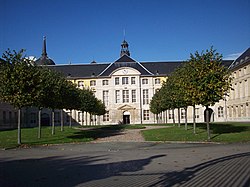Seine-Inférieure
| Seine-Maritime | |||
|---|---|---|---|
| Department | |||

Prefecture building of the Seine-Maritime department, in Rouen
|
|||
|
|||
 Location of Seine-Maritime in France |
|||
| Coordinates: 49°40′N 0°50′E / 49.667°N 0.833°ECoordinates: 49°40′N 0°50′E / 49.667°N 0.833°E | |||
| Country | France | ||
| Region | Normandy | ||
| Prefecture | Rouen | ||
| Subprefectures |
Dieppe Le Havre |
||
| Government | |||
| • President of the General Council | Pascal Martin | ||
| Area | |||
| • Total | 6,278 km2 (2,424 sq mi) | ||
| Population (2013) | |||
| • Total | 1,254,609 | ||
| • Rank | 14th | ||
| • Density | 200/km2 (520/sq mi) | ||
| Time zone | CET (UTC+1) | ||
| • Summer (DST) | CEST (UTC+2) | ||
| Department number | 76 | ||
| Arrondissements | 3 | ||
| Cantons | 35 | ||
| Communes | 710 | ||
| ^1 French Land Register data, which exclude estuaries, and lakes, ponds, and glaciers larger than 1 km2 | |||
Seine-Maritime (French pronunciation: [sɛn.ma.ʁi.tim]) is a department of France in the Normandy region of northern France. It is situated on the northern coast of France, at the mouth of the Seine, and includes the cities of Rouen and Le Havre. Until 1955 it was named Seine-Inférieure.
The department can be split into three main areas:
The département was created in 1790 as Seine-Inférieure, one of five departements that replaced the former province of Normandy. In 1800 five arrondissements were created within the département, namely Rouen, Le Havre, Dieppe, Neufchatel and Yvetot, although the latter two were disbanded in 1926. On 18 January 1955 the name of the département was changed to Seine-Maritime, in order to provide a more positive-sounding name and in-keeping with changes made in a number of other French departements.
In 1843 the railway from Paris reached the region. The département is connected to the adjacent Eure department via the Tancarville and Pont de Normandie bridge crossings of the Seine.
Madame Bovary by Gustave Flaubert is set in Seine Maritime.
...
Wikipedia


